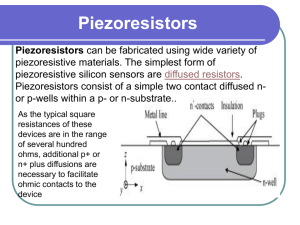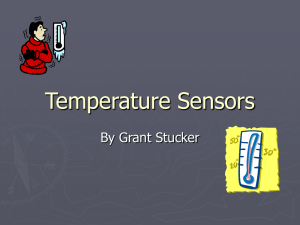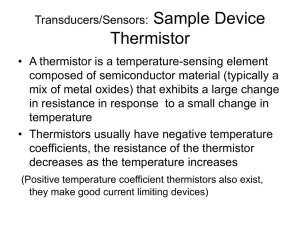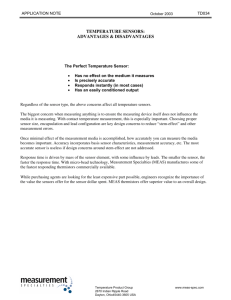Published in Sensor Technology Alert (3 October 2014)
advertisement
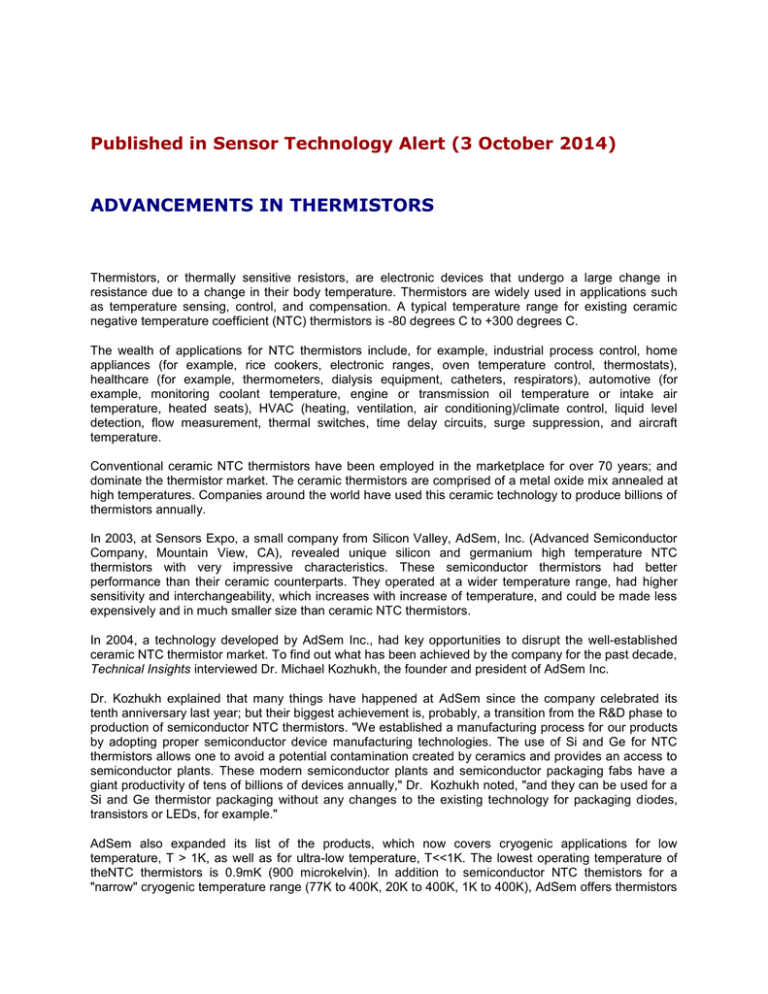
Published in Sensor Technology Alert (3 October 2014) ADVANCEMENTS IN THERMISTORS Thermistors, or thermally sensitive resistors, are electronic devices that undergo a large change in resistance due to a change in their body temperature. Thermistors are widely used in applications such as temperature sensing, control, and compensation. A typical temperature range for existing ceramic negative temperature coefficient (NTC) thermistors is -80 degrees C to +300 degrees C. The wealth of applications for NTC thermistors include, for example, industrial process control, home appliances (for example, rice cookers, electronic ranges, oven temperature control, thermostats), healthcare (for example, thermometers, dialysis equipment, catheters, respirators), automotive (for example, monitoring coolant temperature, engine or transmission oil temperature or intake air temperature, heated seats), HVAC (heating, ventilation, air conditioning)/climate control, liquid level detection, flow measurement, thermal switches, time delay circuits, surge suppression, and aircraft temperature. Conventional ceramic NTC thermistors have been employed in the marketplace for over 70 years; and dominate the thermistor market. The ceramic thermistors are comprised of a metal oxide mix annealed at high temperatures. Companies around the world have used this ceramic technology to produce billions of thermistors annually. In 2003, at Sensors Expo, a small company from Silicon Valley, AdSem, Inc. (Advanced Semiconductor Company, Mountain View, CA), revealed unique silicon and germanium high temperature NTC thermistors with very impressive characteristics. These semiconductor thermistors had better performance than their ceramic counterparts. They operated at a wider temperature range, had higher sensitivity and interchangeability, which increases with increase of temperature, and could be made less expensively and in much smaller size than ceramic NTC thermistors. In 2004, a technology developed by AdSem Inc., had key opportunities to disrupt the well-established ceramic NTC thermistor market. To find out what has been achieved by the company for the past decade, Technical Insights interviewed Dr. Michael Kozhukh, the founder and president of AdSem Inc. Dr. Kozhukh explained that many things have happened at AdSem since the company celebrated its tenth anniversary last year; but their biggest achievement is, probably, a transition from the R&D phase to production of semiconductor NTC thermistors. "We established a manufacturing process for our products by adopting proper semiconductor device manufacturing technologies. The use of Si and Ge for NTC thermistors allows one to avoid a potential contamination created by ceramics and provides an access to semiconductor plants. These modern semiconductor plants and semiconductor packaging fabs have a giant productivity of tens of billions of devices annually," Dr. Kozhukh noted, "and they can be used for a Si and Ge thermistor packaging without any changes to the existing technology for packaging diodes, transistors or LEDs, for example." AdSem also expanded its list of the products, which now covers cryogenic applications for low temperature, T > 1K, as well as for ultra-low temperature, T<<1K. The lowest operating temperature of theNTC thermistors is 0.9mK (900 microkelvin). In addition to semiconductor NTC themistors for a "narrow" cryogenic temperature range (77K to 400K, 20K to 400K, 1K to 400K), AdSem offers thermistors with a super-wide operating temperature range from a few mK to about 700K, thermistors with decreased sensitivity to magnetic fields up to 5T (Tesla) at helium temperatures and thermistors with increased radiation hardness. For nuclear bolometers/X-ray spectrometry, AdSem developed thick silicon (Si) and germanium (Ge) thermistors with large surface area, which increases the operational energy and registration efficiency of these devices. Dr. Kozhukh noted that AdSem is the only company in the world that offers inexpensive NTC thermistors with superior performance and very competitive pricing for operating temperatures from 1 mK and up to 500 degrees C. AdSem also developed and offers the smallest NTC thermistors on the market both for high and cryogenic temperatures. Regarding the extensiveness of AdSem’s intellectual property, AdSem Inc., has a number of patents in the thermistor field and a lot of "know-how." While AdSem offers an impressive list of products and has solid IP protection, Dr. Kozhukh noted that, unfortunately, the company has not yet managed to change the landscape of the NTC thermistor industry. AdSem has an amazing large scale manufacturing technology for a Si and Ge NTC thermistor production, he explained, but, regrettably, they do not use these capabilities in full. Dr. Kozhukh explained that there is no doubt that demand for semiconductor NTC thermistors exists, and they can and will replace ceramic thermistors. Currently, AdSem sells Si and Ge high temperature and cryogenic NTC thermistors on-line to many customers all over the world, including leading international and US institutions, who are looking for high-performance NTC thermistors or unique thermistors for novel applications. Unfortunately, this is a minuscule part of AdSem’s potential customer base, and it has insignificant requirements for product volume. Despite the company’s intriguing and innovative products, majority of its potential customers are still unaware of inexpensive semiconductor NTC thermistors and their high performance characteristics and continue using ceramic thermistors. AdSem has a limited internal funding, and because of that they do not have a significant sales and marketing force to convert the ceramic thermistor users into its customers. The company focusses on new technology development and establishing a cost-effective manufacturing process, which it considers as its strongest side, and it chose to direct almost all available funds into these areas. AdSem is trying to find the right solution to its current problems. AdSem did have a number of offers from venture capitalists (VCs), but they were unacceptable. Cooperation with thermistor manufacturers has not happened because they are not interested in supporting semiconductor NTC thermistors, which have better performance than their ceramic thermistors. Nevertheless, AdSem continues working on improvement of its sales and marketing departments and on finding suitable cooperation. Dr. Kozhukh noted that, fortunately, there are many companies in different industries, to which cooperation with AdSem is attractive. For example, there are companies from the temperature measurement industry--thermocouple companies, semiconductor temperature IC manufacturers, platinum and other metal RTD manufacturing companies, infrared temperature sensor manufacturing companies. There are also discreet device (diodes, transistors, light-emitting diode [LED]) and passive device (resistors and capacitors) manufacturing companies, big semiconductor packaging fabs, large instrumentation and semiconductor materials companies, large auto- and medical companies, which use thermistors in their products, and so on. Companies with established temperature sensor sales channels would benefit from extension of their product lines, and consumers of the temperature sensors would get access to AdSem's inventions, advanced products, and cost effective large scale manufacturing technologies. One of the strongest aspects of AdSem is new product development. Dr. Kozhukh noted they developed the first multifunctional (dual function) sensor. In this device the same semiconductor sensor measures two different characteristics at different conditions. Further details about this sensor cannot be disclosed because AdSem is under proper patent law requirements. AdSem is working on a development of its first PTC (positive temperature coefficient) thermistor with an extended operating temperature range (in comparison with existing PTC thermistors) both at its low- and high ends. This thermistor will have significantly higher sensitivity than platinum (Pt) RTD in the whole operating temperature range and will be less expensive than the Pt sensor. For many years, AdSem has been interested in neutron physics, specifically, in mosaic slow neutron monochromator development. During last few years they reached amazing results with Ge mosaic crystals,Dr. Kozhukh explained. NIST (US National Institute of Standards and Technology) tested AdSem’s monochromators at its slow neutron facility and measured 80% to 89% slow neutron reflectivity for Ge monochromators, with mosaicity in the range of 15 to 25 arc minutes. This is an extremly large reflectivity value, it even exceeds the reflectivity of graphite monochromators, which are considered a benchmark for these devices. This is a "dream" result in 70+ years existence of crystal neutron optics, Dr. Kozhukh noted. Such mosaic crystal monochromators are of interest also for gamma- and X-ray optics, specifically, in some medical and astrophysics applications. Technical Insights plans to continue to follow the progress in semiconductor NTC thermistor market development, which could be very important for the temperature sensor industry and its evolution. Details: Dr. Michael Kozhukh, PhD, President, AdSem Inc., 855 Sevely Drive, Mountain View, CA. Phone: +650-625-0642. E-mail: mkozhukh@AdSem.com. Frost & Sullivan Frost & Sullivan, the Growth Partnership Company, enables clients to accelerate growth and achieve best in class positions in growth, innovation and leadership. The company's Growth Partnership Service provides the CEO and the CEO's Growth Team with disciplined research and best practice models to drive the generation, evaluation and implementation of powerful growth strategies. Frost & Sullivan leverages over 50 years of experience in partnering with Global 1000 companies, emerging businesses and the investment community from more than 40 offices on six continents. To join our Growth Partnership, please visit http://www.frost.com.
